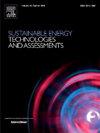Nickel phosphide modified nickel cobaltate as microbial fuel cell anode to facilitate the treatment of shale gas flowback wastewater: Electricity generation performance and mechanism
IF 7.1
2区 工程技术
Q1 ENERGY & FUELS
Sustainable Energy Technologies and Assessments
Pub Date : 2025-01-01
DOI:10.1016/j.seta.2024.104127
引用次数: 0
Abstract
How to treat the actual shale gas flowback wastewater (FW) is a serious challenge for the unconventional gas industry. Herein, an environmentally friendly and energy reusable green technology microbial fuel cell(MFC)is reported. Ni-P is electrodeposited on NiCo2O4/ carbon cloth (CC) electrode as the anode of MFC and used to treat actual FW to observe the power generation and degradation performance. The high conductivity and large specific surface of the composites positively improve the formation of biofilm on the electrode surface and reduce the influence of electron transfer. Moreover, the smaller charge transfer resistance of the composite electrode compared to the CC and NiCo2O4/CC lays the foundation for its excellent power production performance. As the Ni-P@NiCo2O4 anode MFC is run for 34 days, there is a maximum output voltage of 522.4 mV, and the removal of chemical demand is 61.55 %, which is better than the CC (26 d, 362.5 mV, 49.74 %). High-throughput testing shows that Desulfobacterota is the dominant electroactive bacterium and that modified electrodes can dramatically alter the enrichment of the dominant species. Therefore, this work is important for the resource utilization of FW, practical application and performance improvement of MFC.
求助全文
约1分钟内获得全文
求助全文
来源期刊

Sustainable Energy Technologies and Assessments
Energy-Renewable Energy, Sustainability and the Environment
CiteScore
12.70
自引率
12.50%
发文量
1091
期刊介绍:
Encouraging a transition to a sustainable energy future is imperative for our world. Technologies that enable this shift in various sectors like transportation, heating, and power systems are of utmost importance. Sustainable Energy Technologies and Assessments welcomes papers focusing on a range of aspects and levels of technological advancements in energy generation and utilization. The aim is to reduce the negative environmental impact associated with energy production and consumption, spanning from laboratory experiments to real-world applications in the commercial sector.
 求助内容:
求助内容: 应助结果提醒方式:
应助结果提醒方式:


